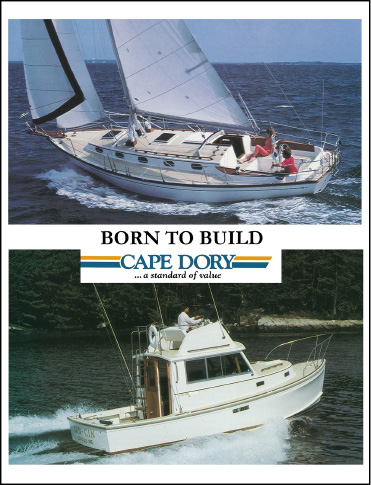By Andy Vavolotis and Jim Nelson
Review by Dave Hemenway
 I have owned a 1966 Cape Dory 10 dinghy since the 1980s and have followed Cape Dory boats for many years. I also own a Greenwich 24, the precursor to the Cape Dory 25, one of Cape Dory’s most successful models. Cape Dory boats have always made sense to me and I have enjoyed sailing on several of their models. I joined the Cape Dory Sailboat Owner’s Association (CDSOA) several years ago and currently serve as the fleet captain of the Northeast fleet.
I have owned a 1966 Cape Dory 10 dinghy since the 1980s and have followed Cape Dory boats for many years. I also own a Greenwich 24, the precursor to the Cape Dory 25, one of Cape Dory’s most successful models. Cape Dory boats have always made sense to me and I have enjoyed sailing on several of their models. I joined the Cape Dory Sailboat Owner’s Association (CDSOA) several years ago and currently serve as the fleet captain of the Northeast fleet.
In March 2024, I attended the CDSOA Cabin Fever meeting at Newick’s Lobster House in Dover, New Hampshire where Andy Vavolotis gave the keynote address on the book he wrote with Jim Nelson detailing the rise and fall of the Cape Dory company. He told a fascinating story, accompanied by many members of his former company who spoke about their Cape Dory experiences and stressed the teamwork and leadership that Andy Vavolotis provided to the company.
Born to Build tells the story of the Cape Dory Company from a young Andy building dinghies in his parents’ garage while figuring out how to improve his techniques and develop his fledgling company. It’s the classic tale of a driven person who had a dream and made it happen. He saw the future in fiberglass boat building and rode the wave as sailors pursued the opportunity of owning their own boat.
I was particularly interested in Andy’s efforts to ensure quality and continually improve boats while meeting the needs of his customers. His staff talked about the rigorous quality controls at Cape Dory. He was an early adopter of total quality improvement: “I was always interested in efficiency, but I was just as interested in quality. The goal was not to produce a boat as quickly as possible. It was to produce the best boat we could make as quickly as possible.” Balancing these different aspects is a challenging task that Cape Dory did well for many years. The best testimony to the success of these efforts is the large number of Cape Dory boats still in use. Cape Dory built 8,566 boats between 1963 and 1990, when the factory closed down.
An example of Cape Dory’s efficiency was building interior sections outside of a hull and installing them before the hull and deck sections were joined. This saved considerable time in the building process and kept production costs down. Another efficiency strategy was to build kits for each system before a worker started work in that area. For example, when installing an engine, the kit would include all the properly sized parts needed for that job…I can’t do any boat project without a couple trips to the hardware store!
One of the things that struck me was how Andy and his team had mastered the production of fiberglass boats and fully utilized their thoughtful techniques, and then the boating market and tax laws completely changed the economics of their operation.
Cape Dory tried to change with the difficult challenges facing the marine business. Born to Build discusses these attempts, delving into those that succeeded and those that did not. While I knew Cape Dory built a few powerboats, I didn’t know about the Intrepid series of fin keel sailboats or the fancy, fast powerboats they produced. In my mind, this was a strange deviation from the Cape Dory philosophy. Apparently it was also strange to the sailing public, which didn’t welcome these boats which were quite unlike Cape Dory’s traditional full keel sailboats with their teak woodwork.
Born to Build is a wonderful book if you’re interested in an unvarnished insider view of Cape Dory Yachts over its history. The authors freely discuss what worked and what didn’t. I learned an incredible amount on how fiberglass boat building progressed through the last 35 years of the twentieth century. It’s a good read for people interested in Cape Dorys and the fiberglass boat building environment of that era. It’s available from Andy Vavolotis’ website at capedoryhistory.com. The soft backed version is $44.95 while the hardcover edition is $59.95 plus $9.95 shipping and handling. It is not available in bookstores or from Amazon. ■
Dave Hemenway lives in Eastern Connecticut and sails out of Thames Yacht Club in New London. He’s been sailing and messing about in boats for his whole life and has recreationally sailed Finns on and off since the 1970s. His primary cruising boat is a Dickerson 36 yawl that he has maintained and improved for 35 years. Since his retirement from higher education, he has worked at Cappy’s Boat Shop where he reports to his dog, Cappy.



